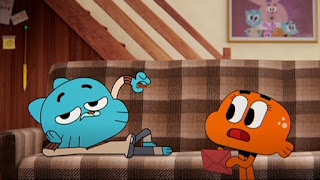It's about Gumball Waterson and his "pet fish", Darwin (though he's more like his sibling), who get into all sorts of trouble at school and at home. It's kind of like a sitcom, if you added in the zaniness of cartoons into the equation.
Anyway, it's pretty unique visually because it mixes in a bunch of different styles together, all at once.
"What? That doesn't make any sense???" you may say.
Well, here's the cast.
Well, here's the cast.
Yep! Like, every character is animated in a different way. We've got the standard 2D stuff, but we've also got CG and puppets and pixel art and some other things in there as well.
That's… pretty nuts, huh?
And while it's not the first case of blending styles together (some cartoons enjoy placing photographs as jokes), Gumball is an example of a show that really has them mesh together in a single coherent universe.
But how?
Well, let's start with something I haven't covered very much yet: backgrounds.
Despite being a cartoon, generally, Gumball's backgrounds have pretty neutral colours. Nothing too bright or unnaturally vibrant. They're also really really photo-realistic.
 |
| Doesn't this look like a photo to you? Heck, it might even be a photo. |
But how do they do it?
One word.
Interaction.
They aren't just placed as props over the environment. They physically interact with it like any other place.
And, on top of them doing that with their actions, the physics behind their bodies does the same thing.
At the school, if you look closely beneath their feet: not only do they have shadows, but they leave reflections against the tiles.
 |
| Those lockers look really shiny. |
In terms of just being there, subtle gradients and lighting effects are applied to the characters themselves so that their own colours fit with where they're at. If the place they're in has dull lighting, the characters' palettes become darker as well.
The picture of Gumball on the couch is one example of a subtle lighting effect. Here's a more dramatic one.
And, if they're outside, the shadows beneath their feet become much harsher to reflect the sun's light.
Now, this isn't to say that seeing characters side-by-side can't be jarring. It can be.
However, it does help that they all interact with the environment on a level playing field. It helps sell them as being in the same universe.
Plus, while the character designs are varied, they don't get too wacky or realistic. They're mostly pretty simplistic. Nothing too out of the ordinary, so nobody is too removed from anyone else.
That's all I have for now. I could go over more, but the way that characters interact with their environment is the main thing I wanted to cover in this post.
See you next Sunday!




No comments:
Post a Comment